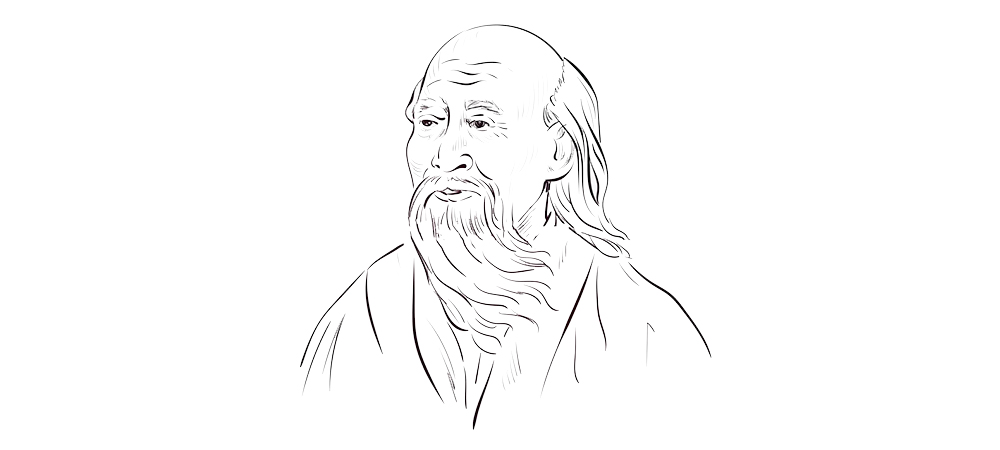So little is known for certain about the author of the Daode jing, who is traditionally assumed to be Laozi (Lao Tzu). He has become an almost mythical figure; it has even been suggested that the book was not by Laozi, but is in fact a compilation of sayings by a number of scholars.
What we do know is that there was a scholar born in the state of Chu, with the name Li Er or Lao Tan, during the Zhou dynasty, who became known as Laozi (the Old Master). Several texts indicate that he was an archivist at the Zhou court, and that Confucius consulted him on rituals and ceremonies. Legend states that Laozi left the court as the Zhou dynasty declined, and journeyed west in search of solitude. As he was about to cross the border, one of the guards recognized him and asked for a record of his wisdom. Laozi wrote the Daode jing for him, and then continued on his way, never to be seen again.
In the 6th century BCE, China moved toward a state of internal warfare as the ruling Zhou Dynasty disintegrated. This change bred a new social class of administrators and magistrates within the courts, who occupied themselves with the business of devising strategies for ruling more effectively. The large body of ideas that was produced by these officials became known as the Hundred Schools of Thought. All this coincided with the emergence of philosophy in Greece, and shared some of its concerns, such as seeking stability in a constantly changing world, and alternatives to what had previously been prescribed by religion.
Knowing others is intelligence; knowing yourself is true wisdom
~Laozi~
But Chinese philosophy evolved from practical politics and was therefore concerned with morality and ethics rather than the nature of the cosmos. One of the most important ideas to appear at this time came from the Daode jing (The Way and its Power), which has been attributed to Laozi (Lao Tzu). It was one of the first attempts to propose a theory of just rule, based on de (virtue), which could be found by following dao (the Way), and forms the basis of the philosophy known as Daoism.
Cycles of change
In order to understand the concept of dao, it is necessary to know how the ancient Chinese viewed the ever-changing world. For them, the changes are cyclical, continually moving from one state to another, such as from night to day, summer to winter, and so on. They saw the different states not as opposites, but as related, one arising from the other. These states also possess complementary properties that together make up a whole. The process of change is seen as an expression of dao, and leads to the 10,000 manifestations that make up the world. Laozi, in the Daode jing, says that humans are merely one of these 10,000 manifestations and have no special status. But because of our desire and free will, we can stray from the dao, and disturb the world’s harmonious balance. To live a virtuous life means acting in accordance with the dao.
Following the dao, however, is not a simple matter, as the Daode jing acknowledges. Philosophizing about dao is pointless, as it is beyond anything that humans can conceive of. It is characterized by wu (“not-being”), so we can only live according to the dao by wu wei, literally “non-action.” By this Laozi does not mean “not doing”, but acting in accordance with nature—spontaneously and intuitively. That in turn entails acting without desire, ambition, or recourse to social conventions.
The main concept in Taoist doctrine is dao (道; pinyin: dào), whose etymological meaning is “the way”. Dao is the invisible and intangible, yet omnipresent, eternal and all-embracing manifestation of nature, or of all that exists, which can be felt in the path of the stars, the changing of day and night, the seasons, etc. Dao, as a symbolic but also real manifestation of these laws, is also found in the Confucian classics.
A characteristic feature of this doctrine is that it emphasises the organic connection between the laws of external nature and the laws of human or social life, where Daoists conceived of their world as a naturally given freedom. Rather than being an ethical category characteristic of the Confucian Tao, the Taoists use the same concept primarily as a holistic cosmogonic term – it is the naturally given path (law) of the eternal transformation of the universe and of all that exists. Daoist thought is characterised by the absence of everything absolute, which is reflected in the eternity of the Dao.
The taijitu (太極圖; tàijítú; commonly known as the “yin and yang symbol” or simply the “yin yang”) and the Bagua 八卦 (“Eight Trigrams”) have importance in Taoist symbolism. In this cosmology, the universe creates itself out of a primary chaos of material energy, organized into the cycles of Yin and Yang and formed into objects and lives. Yin is the receptive and Yang is the active principle, seen in all forms of change and difference such as the annual season cycles, the natural landscape, the formation of both men and women as characters, and sociopolitical history. While almost all Taoist organizations make use of it, its principles have influenced Confucian, Neo-Confucian or pan-Chinese theory.
One can see this symbol as a decorative element on Taoist organization flags and logos, temple floors, or stitched into clerical robes. According to Song dynasty sources, it originated around the 10th century CE. Previously, a tiger and a dragon had symbolized yin and yang Taoist temples may fly square or triangular flags. They typically feature mystical writing or diagrams and are intended to fulfill various functions including providing guidance for the spirits of the dead, bringing good fortune, increasing life span, etc.
- This article is an excerpt from the book:
The Philosophy Book – Big Ideas Simply Explained

